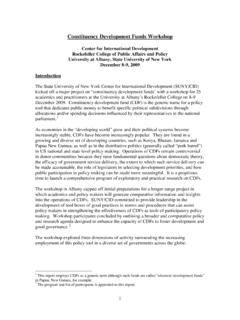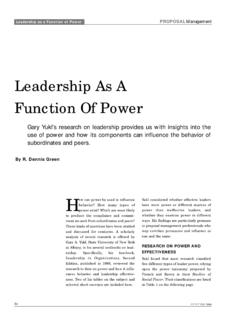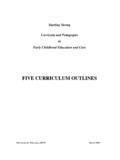Transcription of vi Editor “Cheat Sheet” - University at Albany
1 VI cheat sheet ACNS Bulletin ED 03. February 1995. vi Editor cheat sheet . Invoking vi: vi filename Format of vi commands: [count][command] (count repeats the effect of the command). Command mode versus input mode File management commands Vi starts in command mode. The positioning commands :w name Write edit buffer to file name operate only while vi is in command mode. You switch vi :wq Write to file and quit to input mode by entering any one of several vi input com- :q! Quit without saving changes mands. (See next section.) Once in input mode, any charac- ZZ Same as :wq ter you type is taken to be text and is added to the file. You :sh Execute shell commands (<ctrl>d). cannot execute any commands until you exit input mode. To exit input mode, press the escape (Esc) key. Window motions Input commands (end with Esc) <ctrl>d Scroll down (half a screen). <ctrl>u Scroll up (half a screen). a Append after cursor <ctrl>f Page forward i Insert before cursor <ctrl>b Page backward o Open line below /string Search forward O Open line above ?
2 String Search backward :r file Insert file after current line <ctrl>l Redraw screen Any of these commands leaves vi in input mode until you <ctrl>g Display current line number and press Esc. Pressing the RETURN key will not take you out file information of input mode. n Repeat search N Repeat search reverse Change commands (Input mode) G Go to last line nG Go to line n cw Change word (Esc). :n Go to line n cc Change line (Esc) - blanks line z<CR> Reposition window: cursor at top c$ Change to end of line z. Reposition window: cursor in middle rc Replace character with c z- Reposition window: cursor at bottom R Replace (Esc) - typeover s Substitute (Esc) - 1 char with string S Substitute (Esc) - Rest of line with Cursor motions text H Upper left corner (home).. Repeat last change M Middle line Changes during insert mode L Lower left corner h Back a character <ctrl>h Back one character j Down a line <ctrl>w Back one word k Up a line <ctrl>u Back to beginning of insert ^ Beginning of line $ End of line l Forward a character w One word forward b Back one word fc Find c ; Repeat find (find next c).
3 Deletion commands Move text from file old to file new dd or ndd Delete n lines to general buffer vi old dw Delete word to general buffer a10yy yank 10 lines to buffer a dnw Delete n words :w write work buffer d) Delete to end of sentence :e new edit new file db Delete previous word ap put text from a after cursor D Delete to end of line :30,60w new Write lines 30 to 60 in file new x Delete character Regular expressions (search strings). Recovering deletions ^ Matches beginning of line p Put general buffer after cursor $ Matches end of line P Put general buffer before cursor . Matches any single character * Matches any previous character Undo commands .* Matches any character u Undo last change Search and replace commands U Undo all changes on line Rearrangement commands Syntax: :[address]s/old_text/new_text/. yy or Y Yank (copy) line to general buffer z6yy Yank 6 lines to buffer z Address components: yw Yank word to general buffer . Current line a9dd Delete 9 lines to buffer a n Line number n A9dd Delete 9 lines; Append to buffer a.
4 +m Current line plus m lines ap Put text from buffer a after cursor $ Last line p Put general buffer after cursor /string/ A line that contains "string". P Put general buffer before cursor % Entire file J Join lines [addr1],[addr2] Specifies a range Examples: Parameters The following example replaces only the first occur- :set list Show invisible characters rence of Banana with Kumquat in each of 11 lines :set nolist Don't show invisible characters starting with the current line (.) and continuing for the 10 that follow (.+10). :set number Show line numbers :set nonumber Don't show line numbers :.,.+10s/Banana/Kumquat :set autoindent Indent after carriage return The following example replaces every occurrence :set noautoindentTurn off autoindent (caused by the g at the end of the command) of :set showmatch Show matching sets of apple with pear. parentheses as they are typed :set noshowmatch Turn off showmatch :%s/apple/pear/g :set showmode Display mode on last line of screen The following example removes the last character from :set noshowmode Turn off showmode every line in the file.
5 Use it if every line in the file ends :set all Show values of all possible with ^M as the result of a file transfer. Execute it parameters when the cursor is on the first line of the file. :%s/.$//.





